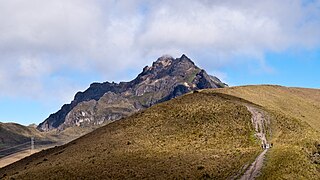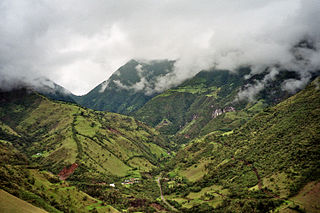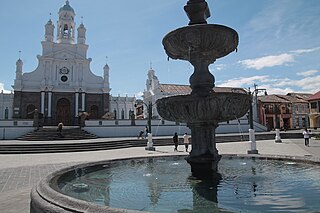Quito is the capital city of Ecuador and the seat of the Quito canton.
Contents
Quito may also refer to:
Quito is the capital city of Ecuador and the seat of the Quito canton.
Quito may also refer to:

Quito, officially San Francisco de Quito, is the capital and second-largest city of Ecuador, with an estimated population of 2.8 million in its metropolitan area. It is also the capital of the province of Pichincha. Quito is located in a valley on the eastern slopes of Pichincha, an active stratovolcano in the Andes.

Pichincha is a stratovolcano in Ecuador. The capital Quito wraps around its eastern slopes.

Pichincha is a province of Ecuador located in the northern Sierra region; its capital and largest city is Quito. It is bordered by Imbabura and Esmeraldas to the north, Cotopaxi and Santo Domingo de los Tsáchilas to the south, Napo and Sucumbíos to the east, and Esmeraldas and Santo Domingo de los Tsáchilas to the west.
Cochabamba or Quchapampa may refer to:

Quito, officially the Metropolitan District of Quito, is a canton in the province of Pichincha, Ecuador.

Mejía is a canton in the province of Pichincha in northern Ecuador. It is named after Ecuadorian political figure José Mejía Lequerica. The canton includes a volcano in the Central Cordillera of the Ecuadorian Andes called Rumiñahui. The seat of the canton is called Machachi.

Pedro Moncayo is a canton in the north of the Pichincha Province, Ecuador. The seat of the canton is the city of Tabacundo. The canton is named after politician Pedro Moncayo. The canton is separated by the Mojanda volcano from the canton of Otavalo in the province of Imbabura in the north. It borders the same-province cantons of Cayambe and Quito.

Puerto Quito is a canton in Pichincha Province, Ecuador. It has only one parish, the urban parish of Puerto Quito, which is also the seat of the canton.

San Miguel de los Bancos, or simply Los Bancos, is a canton in the province of Pichincha, Ecuador. The long name of the town refers to dedication of the area to the archangel Michael. Local tradition attributes the "Los Bancos" part of the name to the use of tree trunks as benches at the junction of the through road from Quito to Esmeraldas with the road into the Rio Blanco valley.
Pichincha may refer to:

Sangolquí is a suburb of Quito and the seat of Rumiñahui canton in the province of Pichincha, in northern Ecuador. It is connected to Quito by the Autopista General Rumiñahui.

Rumiñahui or Rumiñawi is a canton of Pichincha Province in Ecuador. Its seat is Sangolquí. The canton lies southeast of Quito Canton and forms a suburb of Quito.
Calderón is a Spanish surname.

Santo Domingo de los Tsáchilas is a province in the Republic of Ecuador, created in October 2007 from territory previously in the province of Pichincha.
Mejia, Mejía, Mexia, Mejias or Mejías may refer to:
Lloa is a rural parish of Quito Canton, Pichincha Province, Ecuador. The seat of the parish, which is the village of Lloa, lies west of the southern part of the city of Quito and approximately southeast of Guagua Pichincha Volcano, surrounded by some foothills of the Pichincha Volcano.

San Antonio de Pichincha, or simply San Antonio and less frequently by the older name San Antonio de Lulumpamba, is a rural parish of Quito Canton, Pichincha Province, Ecuador. The seat of the parish lies in an arid plain with sandy soil known as Lulumpamba. The Quechua language name of the plain means plain of fruit(s). It is southeast of Pululahua (Pululagua) Volcano and east of Casitagua Volcano. In the village there is also a Lulumpamba street named after the plain.

Calacalí is a rural parish of Quito Canton, Pichincha Province, Ecuador. It is northwest of Casitagua Volcano and southwest of Pululagua Volcano.

Ecuador is a nation in northwest South America known as the Republic of Ecuador. Hundreds of thousands of kinds of plants and animals can be found there as a result of the diversity of its four zones. There are roughly 1640 bird species there. Along with the 4,500 kinds of butterflies, there are also 345 reptiles, 358 amphibians, and 258 mammals. Ecuador is regarded as one of the 17 nations with the highest concentration of biodiversity on Earth. The majority of its animals and plants are found in 26 state-protected areas. It also provides gastronomy, a range of cultures and customs, and historical attractions like Quito.
Sucre Parish may refer to: